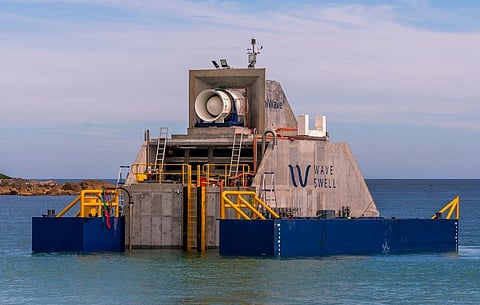

An Australian technology company has embarked on a project that seeks to use ocean waves to generate electricity for consumption by the general public.
Developed by Melbourne-based Wave Swell Energy (WSE), the UniWave200 demonstrator device consists of a cement structure that is anchored to the seabed and is fitted with a large chamber into which ocean waves flow. The waves then cause air to be compressed, and this causes an onboard turbine to spin.
The 200kW wave energy converter is presently stationed in the Bass Strait off the coast of King Island in Tasmania, having been deployed there since February 2021. The unit first generated electrical energy into the Hydro Tasmania grid the following June, benefiting the residents of King Island. Generation was then gradually scaled up, with power being exported intermittently in relatively small sea states while the onboard systems were physically monitored. The unit then began to be operated remotely, with some manual operation required while the control systems continued to be optimised.
The UniWave200 device has operated in a wider range of sea states – even including harsh weather conditions – in the period since then and has proven capable of continuous and autonomous exporting of power into the Hydro Tasmania grid for long periods of time of up to 24 hours straight. The unit has also demonstrated its potential to operate continuously for increasingly extended periods of time.
WSE claims that, under ideal wave conditions, the technology is capable of supplying energy to as many as 200 households.
Over a year since its initial deployment, the UniWave200 project has been regarded as the first successful application of technology that converts wave energy into electrical energy. WSE CEO Paul Geason said in a recent interview with ABC that the demonstrator has yielded conversion rates that are higher than those of other renewable energy technologies. Specifically, around 48 per cent of energy generated by waves is supplied to the King Island electrical grid.
WSE said the success of the project is attributable to the incorporation of a unidirectional turbine in the wave converter. Similar converters developed in other countries utilise bi-directional turbines, which spin when air is pushed out and when it is sucked back in – leading to some members of the public to label such devices as "artificial blowholes" – as waves flow and in out of the chamber.
The unidirectional turbine in the WSE converter promises improvements in efficiency, accessibility, and durability. The company also claims the starting cost is lower than that of either wind power or solar power. Because there are fewer moving parts below the surface of the water, there is reduced wave impact, which translates into a more efficient system and lower maintenance requirements. The technology therefore has the potential of making wave energy as equally viable as wind and solar power as a source of renewable energy for distribution to the public.
Stephanie Thornton of the Australian Ocean Energy Group said that the technology works and is ready to be scaled up. This will then lead to the introduction of additional demonstrator devices, including larger units that are suitable for deployment locally as well as overseas. With a five-fold increase in size, there will also be a five-fold increase in the amount of energy that can be generated.
The UniWave200 technology is also showing promise in other fields such as hydrogen production, ocean desalination, and even coastal protection. In a 2021 interview with CNET, WSE co-founder Tom Denniss said the converters have the potential to also function as seawalls that can protect low-lying coastal communities against the threat posed by severe weather conditions and rising sea levels.
